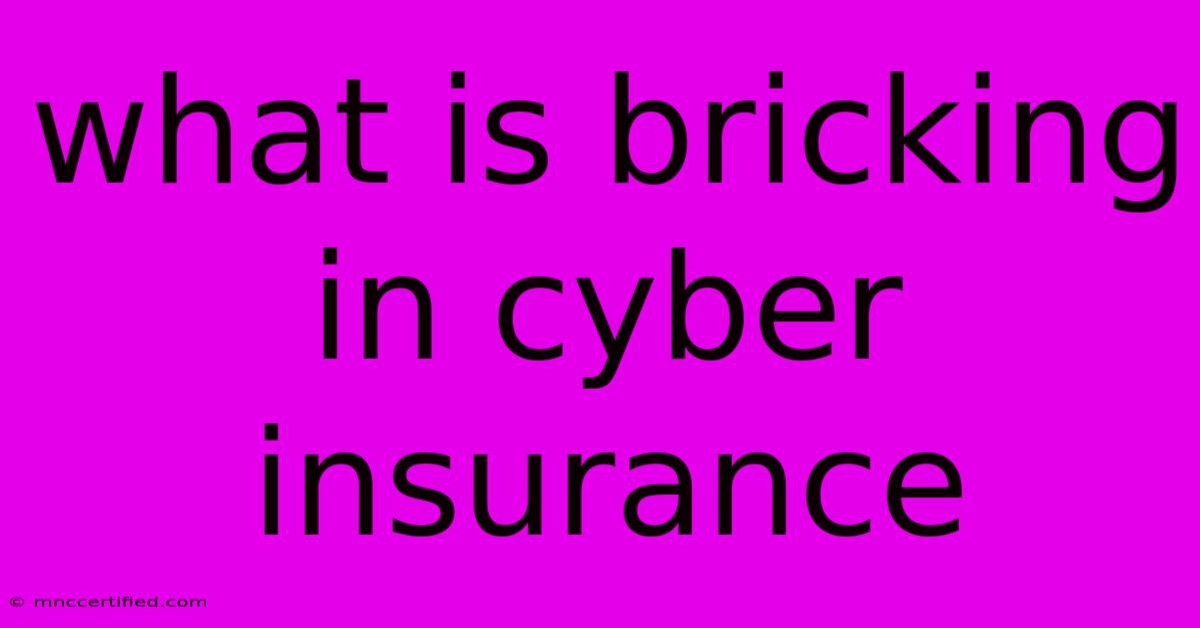What Is Bricking In Cyber Insurance

Table of Contents
What is Bricking in Cyber Insurance? Understanding This Growing Threat
In the ever-evolving landscape of cyber threats, new terms and vulnerabilities emerge constantly. One such term that has gained prominence is "bricking." This seemingly innocuous word represents a serious cybersecurity threat that can cripple your business operations and significantly impact your bottom line.
This article delves into the intricacies of bricking, explaining what it is, how it works, and why it's becoming a significant concern for cyber insurance policies.
What is Bricking?
In the context of cybersecurity, bricking refers to the deliberate rendering of a device or system unusable. Imagine your computer, smartphone, or even critical business servers suddenly becoming completely inoperable - unable to boot up, access data, or perform any function. That's essentially what bricking entails.
This attack can be achieved through various methods, including:
- Malware: Malicious software can corrupt the operating system, erase crucial data, or disable key components, effectively rendering the device unusable.
- Firmware Attacks: These target the firmware, the embedded software that controls the hardware, making it impossible for the device to function correctly.
- Denial of Service (DoS) Attacks: These attacks overload a device or system with requests, preventing it from responding to legitimate traffic and effectively causing a shutdown.
Bricking and Cyber Insurance: A Complex Relationship
The implications of bricking extend beyond a mere inconvenience. It can significantly disrupt business operations, leading to:
- Loss of Productivity: Bricked devices mean lost work time, potentially impacting critical projects and deadlines.
- Data Loss: Bricking can result in the loss of valuable data, including customer information, financial records, and intellectual property.
- Financial Losses: The downtime and data recovery efforts can lead to significant financial losses, especially for businesses reliant on technology.
Cyber insurance policies are designed to mitigate some of these financial risks. However, bricking presents unique challenges for insurance coverage:
- Determining Cause: Proving the cause of bricking can be complex, requiring expert investigation to determine if it was a deliberate act or a technical malfunction.
- Exclusions: Many cyber insurance policies have exclusions that may not cover bricking, especially if it is a result of negligence or inadequate security measures.
- Coverage Limitations: Even if covered, there may be limitations on the amount of coverage or the extent of reimbursement for losses related to bricking.
How to Protect Your Business from Bricking
While bricking can be a complex and challenging threat, there are several measures you can take to mitigate the risk:
- Invest in Robust Cybersecurity: Implement strong passwords, multi-factor authentication, regular software updates, and comprehensive security solutions to protect your devices and systems.
- Back Up Data Regularly: Regular data backups are crucial to minimize the impact of bricking, allowing you to restore lost data quickly.
- Educate Employees: Train employees on cybersecurity best practices and the dangers of phishing, social engineering, and other common attack vectors.
- Review Cyber Insurance Policies: Understand the coverage details and limitations of your cyber insurance policy, ensuring it adequately addresses bricking risks.
Conclusion: Staying Ahead of the Bricking Threat
Bricking is a growing threat in the cybersecurity landscape, posing significant risks to businesses of all sizes. Understanding the risks and taking proactive steps to prevent and mitigate bricking is crucial for safeguarding your operations and mitigating potential financial losses.
By investing in robust cybersecurity, backing up data, educating employees, and carefully reviewing cyber insurance policies, you can strengthen your defenses and protect your business from the devastating consequences of this emerging threat.

Thank you for visiting our website wich cover about What Is Bricking In Cyber Insurance. We hope the information provided has been useful to you. Feel free to contact us if you have any questions or need further assistance. See you next time and dont miss to bookmark.
Featured Posts
-
Does Eyemart Express Take Insurance
Nov 13, 2024
-
Trumps Education Plan Impact On Schools
Nov 13, 2024
-
Celtics Begin Nba Cup Run Against Hawks
Nov 13, 2024
-
Bears Fire Shane Waldron Seek New Oc
Nov 13, 2024
-
Charter Boat Insurance Requirements
Nov 13, 2024